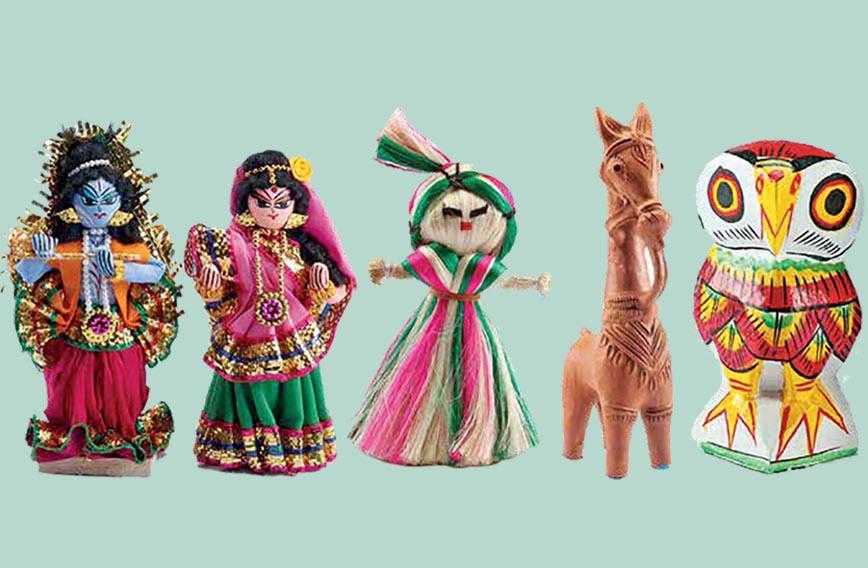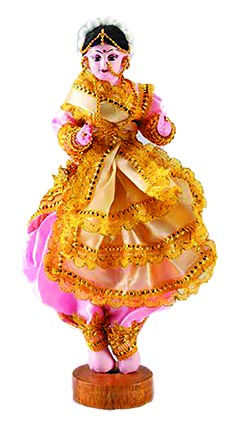
Bengal’s dolls and grandma’s love
Aiema Tauheed, Kolkata
Across districts, artisans keep Bengal’s tradition of doll-making alive using jute, clay, cloth, wood and their own ingenuity to recreate dolls in a more contemporary setting.
Step into an old Bengali home and you might still spot a terracotta horse or elephant adorning the house. These earthy dolls made of clay trace their roots to the village of Panchmura in the late seventh century during the reign of the Malla dynasty.
Panchmura’s craft extends beyond terracotta horses and elephants. There are Shasthi dolls that show a mother with her child, and rail dolls featuring women travelling by train — all reminiscent of life at different junctures in Bengal.
Made with red Bankura soil and fired in village kilns, the dolls have survived the vicissitudes of time and still find space in modern living rooms and houses.
“We believed they acted like protectors, so they were placed at the base of our stairs,” says Joe Sinha, writer at Social Samosa, an online publication. “Growing up, I thought the dolls were alive. Sometimes I’d wonder if the horses were trapped inside them,” he chuckles, recalling his home in Midnapore.
Another beloved handmade doll is the Taal Patar Sepai, or Palm Leaf Sepoy, once so popular that it made its way into Bengal’s vocabulary. The term taal patar sepai is used as an insult for someone who is weak and rickety, yet boasts about their strength. It was invented to describe British sepoys who, it was said, displayed bravado without substance. These sustainable dolls are the oldest form of rod puppets in Bengal, made of palm leaves attached to bamboo sticks.
A gentle twirl between the fingers makes the doll’s arms and legs flail in the breeze, to the delight of children.
Sneha Banerjee, an art enthusiast, recently bought her first taal patar sepai from a hawker who sets up shop outside Nandan Cinema at around 4 pm. “My parents always had one when they were growing up,” she shared. “After I was born, they bought me one too. It never felt like just a doll, it felt like a memory being passed down.”
 She says the hawker told her excitedly. “We also have women taal patar sepai now.” Traditionally, these handmade figures depicted men or animals.
She says the hawker told her excitedly. “We also have women taal patar sepai now.” Traditionally, these handmade figures depicted men or animals.
Madan Mohan Dutta of Burdwan is one of the few artists who still excels at this craft. Among his unique creations is the Saheb O Mem doll, a palm leaf figure that brilliantly shows a man on one side and a woman on the other. His collection also features a series of animal-themed designs.
In traditional Bengali homes, you might still find a wooden owl doll tucked away in a corner, not just as a piece of décor but for prosperity. Some families worship a pair of these owls to seek the blessings of Goddess Lakshmi.
This tradition originates from a once-thriving craft that flourished across Howrah, Bankura, Purulia, and West Midnapore. Today, it’s kept alive in a few villages of Burdwan — Natungram, Daihat, and Patuli — where artisans still carve wooden dolls from white teak or gamhar wood. The figures range from brides and kings to gods and goddesses like Kali, Durga, Shiva.
 When Samadrita Chakraborty, content marketer at Classe365, an online education platform, visited a senior photographer and colleague for a get-together, his elderly, frail wife seemed withdrawn and distant.
When Samadrita Chakraborty, content marketer at Classe365, an online education platform, visited a senior photographer and colleague for a get-together, his elderly, frail wife seemed withdrawn and distant.
As the day unfolded, the woman, weathered by time, warmed to Chakraborty’s presence. Before she left, she handed her a bundle of ragtag dolls, worn, and lovingly stitched. “She had been sewing them since she was newly married,” Chakraborty said. “The dolls were her love language.”
Traditionally, mothers and grandmothers made cloth dolls from discarded clothes, creating them as simple, heartfelt gifts for children. Today, the legacy of this quiet gesture of love is carried forward by artisans in North 24-Parganas.
Dressed in colourful sarees, with their facial features painted, they are gorgeous and durable. These cloth dolls remain a popular and sustainable gifting option, especially for children’s birthdays.
In the rural corners of Murshidabad, women artisans handcraft dolls from discarded jute. Over the years, the process has undergone many changes, with brilliantly dyed, sustainable jute dolls now gracing local markets and craft fairs.
Sadhan Pal and his family are the last known artisans crafting Kanthalia clay dolls. The dolls are rough-hewn, honest, and full of life, showing scenes from village life, a genuine portrayal of the ordinary in rural Bengal.
On your next visit to Kolkata do make a pitstop at Biswa Bangla or The Bengal Store on Park Street. Buy a doll or another artisanal product and help conserve such magical art forms. ν
Comments
Currently there are no Comments. Be first to write a comment!





